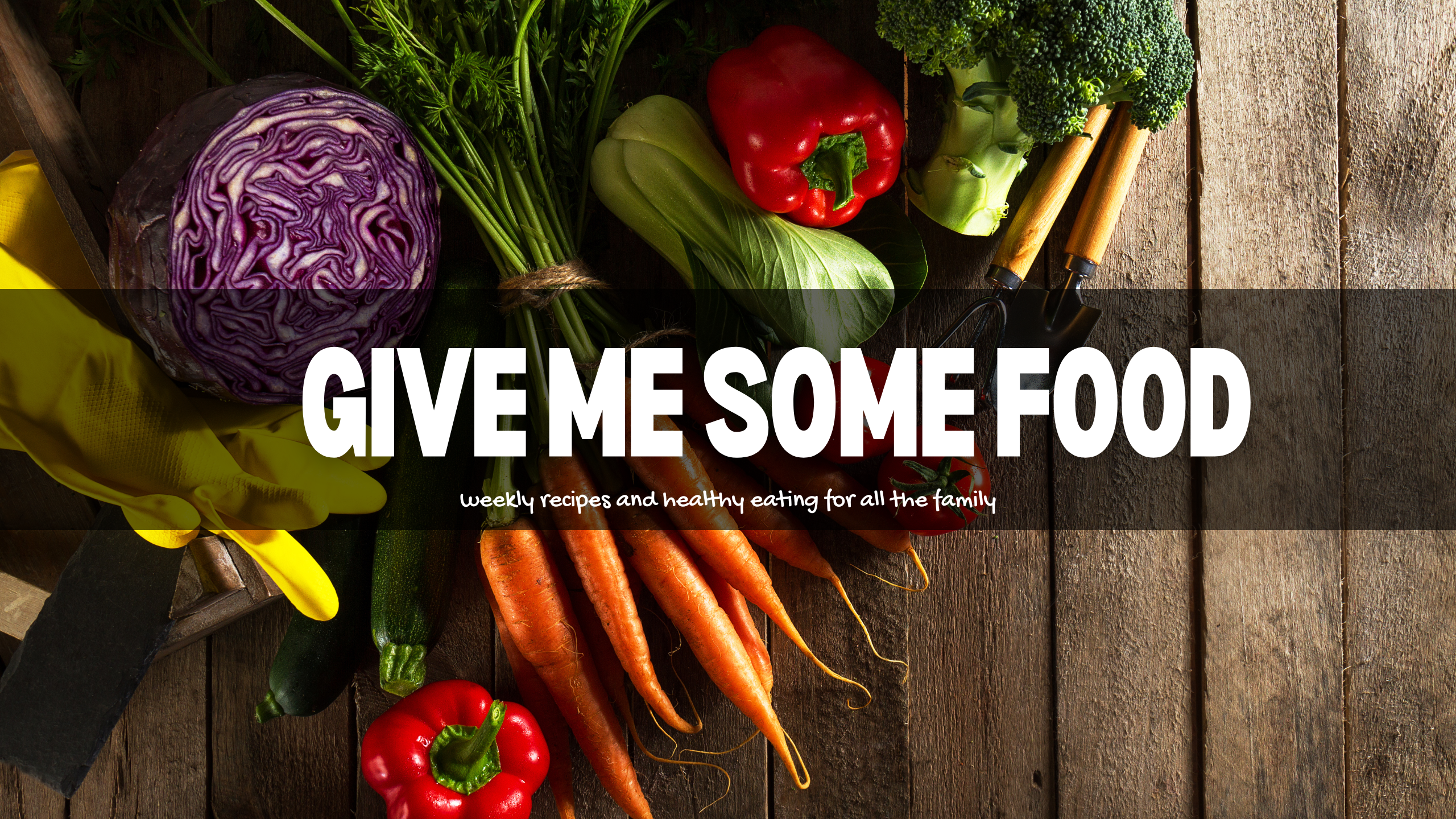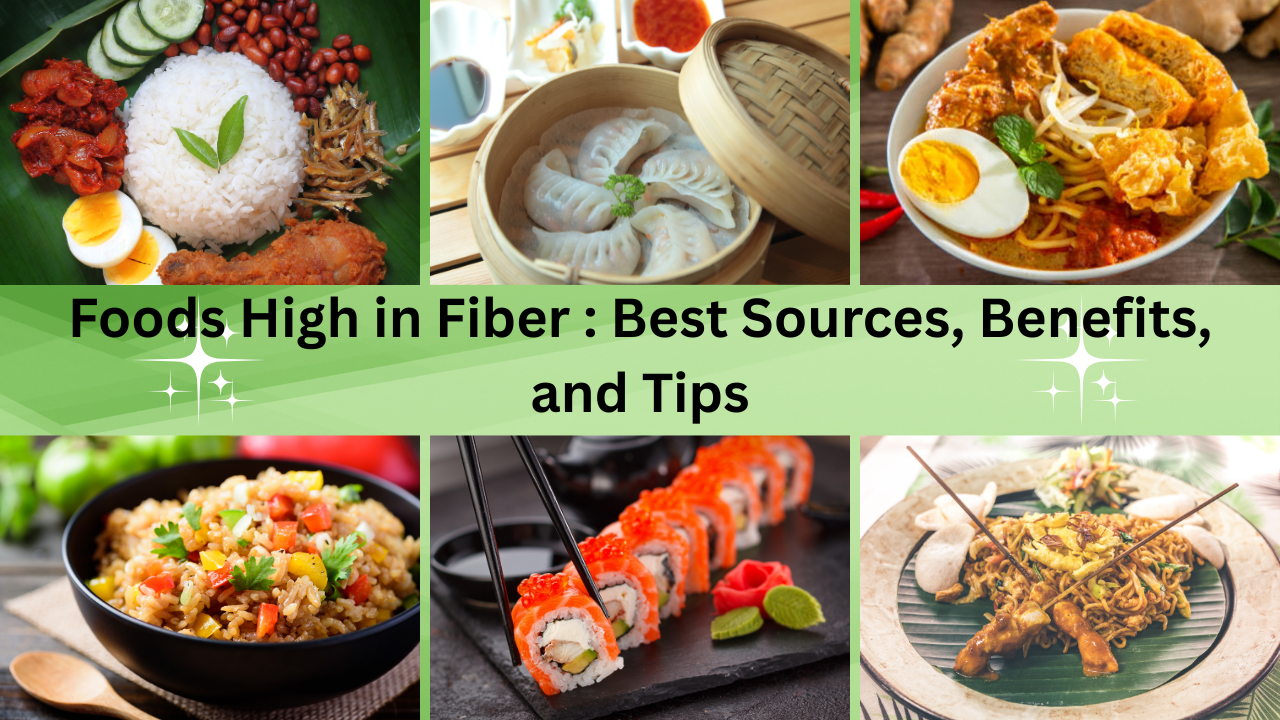High fiber foods are an important part of a healthy diet. They help your body work better by improving digestion and keeping your stomach full for longer. Foods rich in fiber can also support weight control and reduce cravings between meals.
There are two types of fiber: soluble and insoluble. Soluble fiber dissolves in water and helps lower cholesterol and blood sugar. Insoluble fiber helps move food through your digestive system, making bowel movements easier. Including both types in your meals can keep your gut healthy and regular.
Common high fiber foods include fruits, vegetables, whole grains, legumes, seeds, and nuts. Adding these to your daily meals can bring many health benefits. Whether you’re looking to improve digestion, manage your weight, or simply feel more energized, eating more fiber is a simple and effective choice. Start slowly and drink enough water to help your body adjust to the extra fiber.
What Is Dietary Fiber ?
Dietary fiber, also called roughage or bulk, is the part of plant foods that your body cannot digest or absorb. While nutrients like fats, proteins, and carbohydrates are broken down and used by the body, fiber stays mostly unchanged as it moves through the digestive system.
Instead of being digested, fiber passes through the stomach, small intestine, and colon, then leaves the body. This process helps support healthy digestion and regular bowel movements. Including foods high in fiber in your diet—such as fruits, vegetables, whole grains, and legumes—can improve overall health and make digestion easier. Fiber also helps you feel full longer, which may assist with weight management and appetite control.

Fiber is typically classified into two categories:
Soluble fiber is a type of dietary fiber that dissolves in water to form a thick, gel-like substance in the digestive system. This form of fiber plays an important role in lowering levels of harmful cholesterol in the blood and can also help regulate blood sugar levels. Some common examples of foods high in fiber that contain soluble fiber include oats, apples, citrus fruits, carrots, and barley. Including these foods regularly can contribute to heart health and improved blood sugar control.
Insoluble fiber, on the other hand, does not dissolve in water and instead helps move food through the digestive tract more efficiently. It adds bulk to the stool, making it easier to pass, which is especially helpful for individuals experiencing constipation. Good sources of foods high in fiber with insoluble fiber include whole wheat flour, wheat bran, beans, nuts, and a variety of vegetables.
Why Is Fiber Important ?
Fiber is more than just a tool for regularity. It provides numerous health benefits, such as:
Improved digestive health
Lower cholesterol levels
Blood sugar control
Weight management
Reduced risk of chronic diseases like heart disease, type 2 diabetes, and colorectal cancer
The recommended daily intake of fiber is:
25 grams per day for adult women
38 grams per day for adult men
Top Foods High In Fiber
Legumes
Legumes are a powerful and nutritious group of plant foods that include beans, lentils, peas, and chickpeas. They are known for their high content of protein, vitamins, and minerals, making them a valuable addition to any healthy diet. One of their most important benefits is their high fiber content, which supports digestion and overall well-being.
As one of the top foods high in fiber, legumes help promote regular bowel movements and can prevent constipation. The fiber in legumes includes both soluble and insoluble types, which means they can lower cholesterol levels while also supporting a healthy digestive system. Eating legumes regularly may also help manage blood sugar levels, making them a great choice for people with diabetes.
Adding legumes to your meals is simple and versatile. You can include them in soups, salads, curries, or stews. Their fiber content makes you feel full for longer, helping with appetite control and weight management.
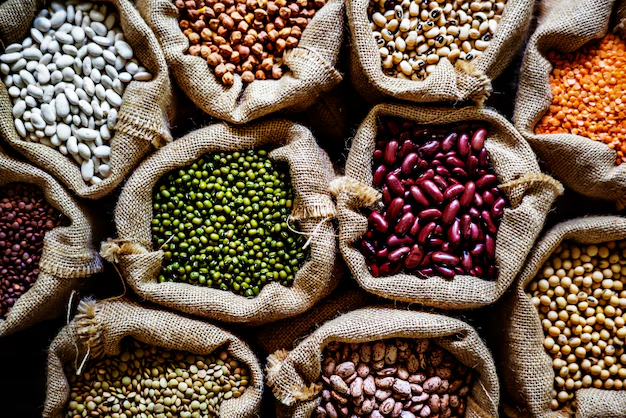
Lentils are among the most nutritious and foods high in fiber, offering an impressive 15.6 grams of fiber per cooked cup. In addition to their fiber content, lentils are rich in plant-based protein, iron, and folate, making them an excellent meat substitute for vegetarians and vegans. Regular consumption of lentils can support digestion, heart health, and energy levels. You can easily incorporate them into your meals by adding them to hearty soups, stews, or mixed into salads for a nutritious fiber boost.
Chickpeas, also known as garbanzo beans, are another valuable source of dietary fiber, delivering approximately 12.5 grams per cooked cup. These legumes are also high in protein and provide important nutrients such as magnesium and folate. As one of the versatile foods high in fiber, chickpeas can be enjoyed in a variety of ways, such as in hummus, warm curries, roasted snacks, or tossed into salads for added texture and nutrition.
Black beans are a standout member of the legume family, offering around 15 grams of fiber in each cooked cup. Their high fiber and resistant starch content make them excellent for supporting digestive health and maintaining stable blood sugar levels. As one of the key foods high in fiber, black beans can be easily included in daily meals. Use them in burritos, hearty soups, or plant-based veggie bowls to enhance the fiber content of your dishes while promoting better gut health.
Whole Grains
Whole grains are essential for a healthy diet and are considered some of the best foods high in fiber. Unlike refined grains, whole grains retain all parts of the grain kernel—the bran, germ, and endosperm—providing more nutrients and fiber. Common whole grains include brown rice, quinoa, oats, whole wheat, barley, and bulgur.
These grains are rich in both soluble and insoluble fiber, which helps improve digestion, lower cholesterol levels, and maintain steady blood sugar. Including whole grains in your meals can also help you feel full for longer, making them useful for weight management. Their slow-digesting nature supports better energy throughout the day.
You can easily enjoy whole grains by choosing whole wheat bread or pasta, starting your day with oatmeal, or adding cooked grains like quinoa or barley to salads and side dishes. As foods high in fiber, whole grains are a smart, tasty way to boost your daily nutrition.
Oats are widely recognized as one of the most beneficial foods high in fiber, especially due to their rich content of beta-glucan—a type of soluble fiber known to help reduce cholesterol levels. A single cup of cooked oats delivers approximately 4 grams of fiber, supporting heart health and improving digestion. Oats can be easily enjoyed as a warm breakfast cereal, blended into smoothies, or used in baking for healthy treats.
Quinoa is a gluten-free, protein-rich whole grain that offers about 5.2 grams of fiber per cooked cup. As one of the most versatile foods high in fiber, quinoa is suitable for individuals with gluten intolerance and provides lasting energy. It can be used in a wide variety of meals, including colorful salads, savory stir-fries, or as a wholesome substitute for rice.
Barley is another exceptional grain, supplying around 6 grams of fiber per cooked cup, with a high concentration of soluble fiber that supports heart health. It is a nourishing addition to soups, grain-based bowls, or served as a flavorful side dish. Brown rice also earns its place among foods high in fiber, with approximately 3.5 grams per cooked cup. Unlike white rice, brown rice retains its outer bran and germ layers, which are responsible for its fiber content. It makes an ideal base for stir-fries, curries, or burrito bowls, contributing both texture and valuable nutrients.
Fruits
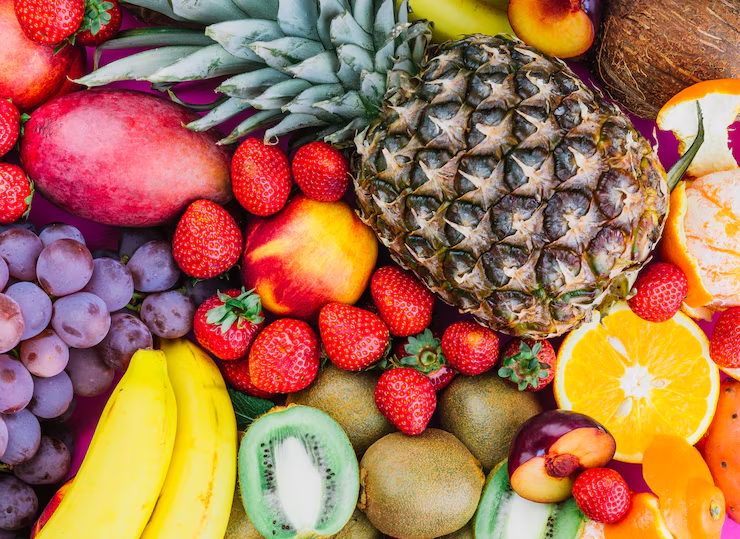
Fruits are naturally sweet, nutrient-rich, and among the most enjoyable foods high in fiber. They are packed with vitamins, antioxidants, and water content, making them great for overall health. Many fruits also contain both soluble and insoluble fiber, which helps support healthy digestion and regular bowel movements.
Some of the best foods high in fiber from the fruit category include apples, pears, berries, bananas, and oranges. These fruits not only add variety and flavor to your meals but also help keep you full and energized throughout the day. The fiber in fruits also plays a role in balancing blood sugar and lowering cholesterol levels.
Eating fruits with the skin, when possible, boosts your fiber intake even more. You can enjoy fruits as snacks, add them to cereals or yogurt, or blend them into smoothies. Including a variety of fiber-rich fruits in your diet is an easy way to stay healthy and feel good.
Raspberries are among the most impressive foods high in fiber, offering approximately 8 grams of fiber per cup. In addition to their fiber content, they are also packed with vitamin C and powerful antioxidants that help support the immune system and fight free radicals. Raspberries can be enjoyed fresh, blended into smoothies, mixed with yogurt, or used as a colorful topping for oatmeal.
Pears are another excellent source of dietary fiber, especially when consumed with their skin. A medium-sized pear provides around 5.5 grams of fiber, contributing to digestive health and a feeling of fullness. As one of the many foods high in fiber, pears are perfect for eating raw, baking into sweet dishes, or slicing into fresh salads for added texture.
Apples contain about 4.4 grams of fiber, most of which is concentrated in the peel, so it is best not to remove the skin. Bananas, while slightly lower in fiber with 3 grams per medium fruit, are still considered good foods high in fiber and are also rich in potassium, which supports heart and muscle function. Apples and bananas are both versatile—they can be eaten raw, baked, added to slaws or salads, sliced onto toast, or blended into nutritious smoothies.
Vegetables
Vegetables are a key part of a healthy diet and are some of the best foods high in fiber. They are naturally low in calories and packed with essential nutrients, including vitamins, minerals, and antioxidants. Eating a variety of vegetables daily helps support overall health, especially digestion and heart function.
Many vegetables contain both soluble and insoluble fiber, which help improve bowel movements and promote a healthy gut. Leafy greens, broccoli, carrots, Brussels sprouts, and sweet potatoes are all excellent foods high in fiber. These vegetables help keep you full, control blood sugar, and support weight management.
You can easily add more vegetables to your meals by roasting, steaming, stir-frying, or including them in soups and salads. Raw or cooked, vegetables are a smart and tasty way to boost your fiber intake. Making them a regular part of your diet supports long-term wellness and digestive health.
Broccoli is a nutrient-dense cruciferous vegetable that stands out as one of the most beneficial foods high in fiber. A single cooked cup of broccoli contains approximately 5.1 grams of fiber, making it an excellent choice for supporting digestive health. It is also rich in vitamins C and K, along with various antioxidants. Broccoli can be enjoyed in many ways, such as steaming, roasting, or stir-frying with garlic and olive oil for added flavor.
Carrots are another valuable addition to a fiber-rich diet, providing around 3.6 grams of fiber per raw cup. Known for their high beta-carotene content, which the body converts to vitamin A, carrots support both vision and immune function. As one of the colorful foods high in fiber, they can be eaten raw with dips, roasted as a side dish, or added to hearty soups and stews.
Brussels sprouts are miniature, cabbage-like vegetables offering about 4 grams of fiber per cooked cup. They are a good source of vitamins C and K and are especially beneficial when roasted with balsamic vinegar, added to fresh salads, or steamed and seasoned. Sweet potatoes, known for their naturally sweet flavor and bright orange flesh, provide approximately 4 grams of fiber per medium-sized potato. As one of the versatile foods high in fiber, they are also rich in vitamin A and can be baked, mashed, or sliced into fries for a healthy, satisfying dish.
Nuts and Seeds
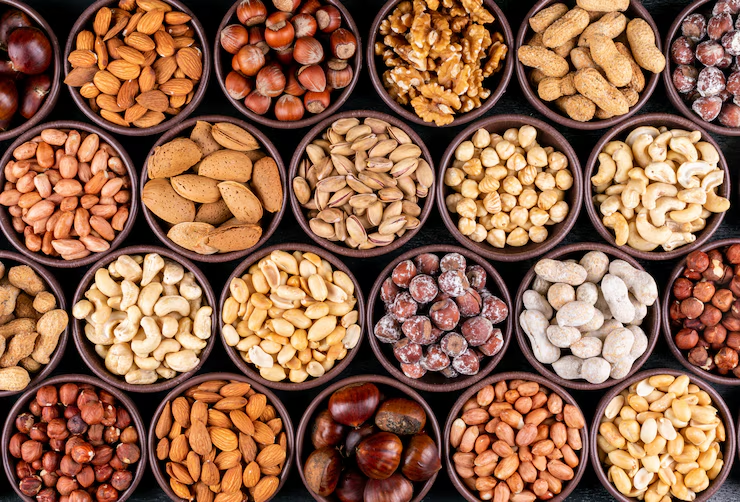
Nuts and seeds are small in size but packed with nutrients, making them excellent foods high in fiber. They provide healthy fats, plant-based protein, vitamins, and minerals that support heart health, brain function, and energy levels. Many varieties also offer a good amount of both soluble and insoluble fiber.
Almonds, chia seeds, flaxseeds, pistachios, and sunflower seeds are some of the top foods high in fiber in this group. Eating them regularly can help improve digestion, support healthy cholesterol levels, and keep you feeling full longer. They’re especially helpful for people trying to manage their weight or maintain steady blood sugar levels.
You can add nuts and seeds to oatmeal, yogurt, smoothies, or baked goods. They also make convenient snacks on their own or as part of trail mixes. Including a variety of fiber-rich nuts and seeds in your daily meals is a simple way to boost your overall fiber intake.
Chia seeds are incredibly rich in nutrients and are considered one of the most concentrated foods high in fiber. Just two tablespoons provide an impressive 10 grams of fiber, along with beneficial omega-3 fatty acids and plant-based protein. These seeds are highly absorbent and can expand when soaked, making them ideal for digestion and prolonged satiety. You can mix chia seeds into yogurt, blend them into smoothies, or create a nutritious chia pudding.
Flaxseeds are another excellent source of fiber, offering approximately 5.6 grams in just two tablespoons. In addition to being one of the valuable foods high in fiber, flaxseeds are known for supporting both heart and digestive health due to their content of lignans and omega-3s. Ground flaxseed can be easily including into smoothies, sprinkled over oatmeal, or used in baking recipes.
Almonds, a popular tree nut, deliver about 3.5 grams of fiber per 1-ounce serving (roughly 23 almonds). They are also packed with vitamin E and healthy fats, making them a nutritious and satisfying snack. Sunflower seeds are another fiber-rich option, offering approximately 3.9 grams of fiber per quarter-cup serving. As tasty foods high in fiber, almonds and sunflower seeds can be enjoyed on their own, added to salads, blended into nut butter, or used as toppings for yogurt and smoothie bowls.
High-Fiber Snacks and Extras
High-fiber snacks and extras are a great way to boost your fiber intake between meals. These small additions can make a big difference in your overall digestive health and help you stay full longer. Choosing the right foods high in fiber for snacking can also help manage cravings and support weight control.
Some healthy snack options include popcorn, air-popped and unsweetened, which is a whole grain that provides a surprising amount of fiber. Other great choices are raw vegetables with hummus, fruit with nut butter, or whole grain crackers. These foods high in fiber are not only satisfying but also rich in nutrients.
Extras like adding ground flaxseeds, chia seeds, or berries to yogurt, oatmeal, or smoothies can easily increase fiber content without changing the taste much. Including high-fiber snacks and add-ons in your daily routine helps support digestion, keep energy steady, and contribute to long-term health.
Popcorn, when air-popped without added butter or sugar, is a wholesome whole grain and a surprisingly effective snack among foods high in fiber. A three-cup serving provides approximately 3.5 grams of fiber while remaining low in calories, making it ideal for those looking to support digestive health or manage weight. For a healthier option, prepare popcorn at home and season it lightly with herbs or natural spices.
Avocados are nutrient-dense fruits that offer not only beneficial monounsaturated fats but also an impressive fiber content—around 10 grams per whole avocado. As one of the more versatile foods high in fiber, avocados support heart and digestive health. You can easily incorporate them into your meals by spreading them on whole grain toast, adding slices to salads, or preparing a creamy guacamole.
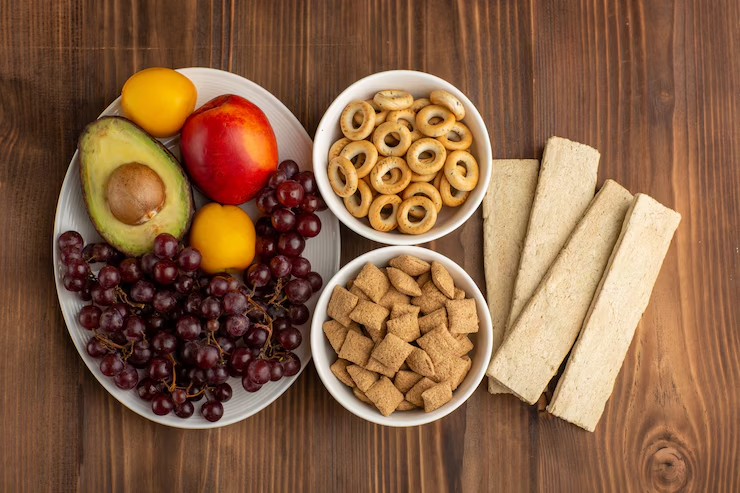
Dark chocolate, particularly varieties containing 70–85% cacao, surprisingly qualifies as one of the indulgent yet effective foods high in fiber. A 100-gram serving can provide up to 10 grams of fiber, alongside antioxidants and minerals. Enjoy a small square as an occasional treat or combine it with nuts and dried fruit to create a fiber-rich snack mix that’s both satisfying and beneficial for your health.
Tips for Increasing Fiber Intake
Start gradually – When adding foods high in fiber to your diet, increase your intake slowly. A sudden jump in fiber can lead to bloating or gas, so give your body time to adjust.
Stay hydrated – Fiber needs water to work properly. Drinking enough fluids helps fiber move smoothly through your digestive system and prevents discomfort.
Pick whole fruits – Instead of drinking fruit juice, choose whole fruits. Juicing removes most of the fiber, while eating the whole fruit keeps all the benefits of foods high in fiber.
Check food labels – When shopping, read nutrition labels carefully. Look for items that list whole grains first and contain at least 3 to 5 grams of fiber per serving.
Make healthy swaps – Replace refined foods with foods high in fiber like whole grain pasta, brown rice, and whole wheat bread. These simple changes help increase your daily fiber without much effort.
Sample One-Day High-Fiber Meal Plan
| Meal | Menu | Estimated Fiber |
|---|---|---|
| Breakfast | Oatmeal with chia seeds, raspberries, and almonds | 12–15g |
| Snack | Apple with peanut butter | 6–8g |
| Lunch | Quinoa salad with chickpeas, broccoli, and vinaigrette | 15g |
| Snack | Air-popped popcorn and a small pear | 7g |
| Dinner | Lentil stew with carrots, kale, and whole grain bread | 20g |
| Dessert | A square of dark chocolate and a few walnuts | 5g |
Conclusion
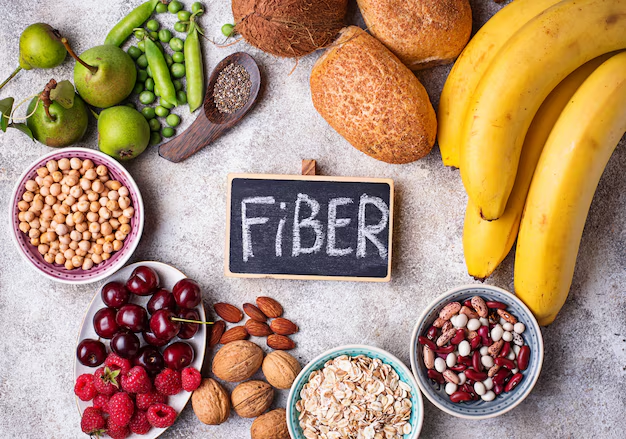
Fiber is an important part of a healthy diet that does more than just support regular digestion. It also helps manage cholesterol, control blood sugar, and maintain a healthy weight. Eating more foods high in fiber may even reduce the risk of long-term health problems such as heart disease and diabetes.
Adding fiber to your meals doesn’t have to be difficult. Many foods high in fiber like legumes, whole grains, fruits, vegetables, nuts, and seeds are easy to find and prepare. By including these foods regularly, you can take meaningful steps toward better overall health and well-being.
The good news is that high-fiber foods are both tasty and versatile. You can stir chia seeds into your morning smoothie, use quinoa instead of white rice, or enjoy simple snacks like raspberries and almonds. Each small change makes a difference, helping you create a healthier lifestyle one meal at a time.
FAQs
- What are some examples of foods high in fiber ?
Foods like lentils, beans, oats, quinoa, whole wheat bread, berries, apples, broccoli, carrots, chia seeds, and almonds are all rich in fiber. - How much fiber should I eat each day ?
Most adults should aim for about 25–30 grams of fiber per day, depending on age and gender. This can be met by eating a variety of plant-based foods. - Can eating too much fiber cause problems ?
Yes, adding too much fiber too quickly can cause bloating, gas, or stomach discomfort. It’s best to increase fiber slowly and drink plenty of water. - Are fruits or vegetables better sources of fiber ?
Both fruits and vegetables are excellent foods high in fiber, and each offers different types and benefits. A mix of both is ideal. - Do fiber supplements work the same as food ?
Fiber supplements can help, but it’s better to get fiber from whole foods, which also provide nutrients, antioxidants, and natural plant compounds.
